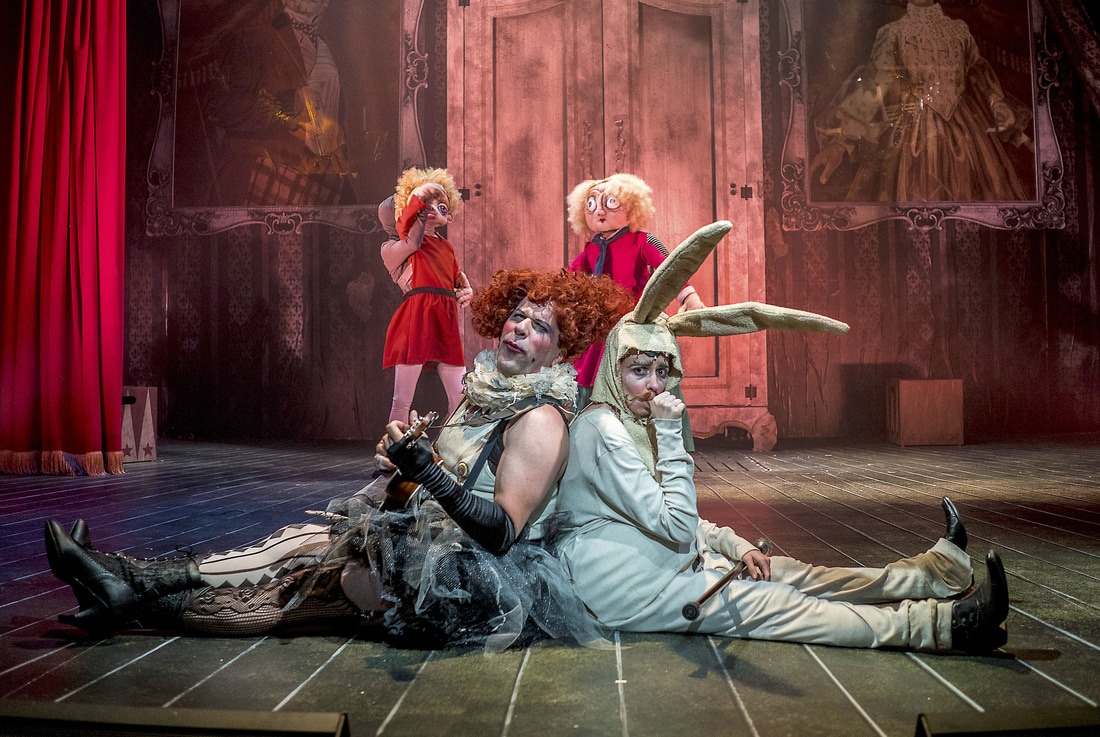|
Paul Alexander Nolan in "Escape to Margaritaville." Photo credit: Matthew Murphy Escape to Margaritaville, the world-premiere musical that kicks off La Jolla Playhouse’s season, is a Parrothead’s dream: a tropical island setting, beautiful people in aloha shirts and skimpy beachwear, and the carefree, sun-splashed songs of Jimmy Buffett. Oh, and a thatched-roof bar on stage that never seems to close.
For casual or non-Buffett fans, Escape to Margaritaville is a good-humored tale with little more at stake than whether a musical “beach bum” named Tully (Paul Alexander Nolan, sounding when he speaks like a NASCAR driver) will win the heart of a comely workaholic from Cincinnati named Rachel (Alison Luff). The authors of the musical’s book, Greg Garcia and Mike O’Malley, do apply some narrative layers, like a volcano that blows its top and Tully’s becoming a big recording star in the States, but really what we care about is whether the young lovers pair up by show’s end. Interestingly, the island romance between Rachel’s body-conscious but less-uptight girlfriend Tammy (Lisa Howard) and an insecure bartender (Charlie Pollock) is more fun than that of the leads. The charm of Escape to Margaritaville, directed by Christopher Ashley, is the ingenuity in which Buffett songs, especially the title tune, are woven into the story and the characters’ fates. Also to its credit are the surreal presence of some ash-covered dancing zombies, a couple of inspired aerial effects (ever try snorkeling in midair?) and wonderful sets by Walt Spangler that will make you long for an island vacation yourself. Bottom line, this is a musical showcase for Buffett’s goodtime canon, and nothing that happens on stage connects more than the songs so beloved by his faithful over the years, performed on stage principally by the likable Nolan and a spirited band conducted by Christopher Jahnke. On opening night, Buffett himself, barefooted and brandishing his guitar, came on stage to lead the cast and audience in a rousing “Margaritaville.” Chill, Parrotheads: He won’t be doing so throughout the show’s run. Next stop for “Escape,” by the way, is New Orleans, a place where they already have partying down to a tee. (Review originally published in San Diego CityBeat on 5/31/17.)
0 Comments
Fairytales have never been as grim as they are in “Shockheaded Peter,” a cleverly fiendish mash-up of morality play and the macabre. In Cygnet Theatre’s enormously creative venture into the bizarro world, a string of naughty children gets what’s coming to them. Do they ever: A petulant thumb sucker gets his appendages snipped off. A fussy eater wastes away to skull and bones. A precocious tot who plays with matches gets burned … to death. Yet in this musical adaptation of German psychiatrist Heinrich Hoffmann’s children’s book “Der Struwwelpeter,” it’s all in diabolical fun. Unlike in Hoffmann’s original fables, the tykes of “Shockheaded Peter,” be they Cruel Frederick, Johnny Head-in-Air or the Bully Boys, always meet with fatal consequences. The authors of this 1998 transmogrification are Julian Crouch and Phelim McDermott of London’s Improbable Theatre, along with the British musical trio The Tiger Lillies, progenitors of what’s come to be known as Brechtian punk cabaret. “Shockheaded Peter” is all that and more, a theatrical carnival of garish face paint, animal heads and masks, puppetry and acrobatics. What must be a daunting challenge to bring off in one 90-minute show is met with ingenuity at Cygnet under the direction of Rob Lutfy, along with a gifted production team that includes costume and puppet designer Shirley Pierson and choreographer Michael Mizerany. “Shockheaded Peter’s” nightmare-before-bedtime stories are played out for horrified laughter by a versatile ensemble frequently manipulating props and puppets. The two characters out front are the mustached Emcee (Sarah Errington, in a knowing role that’s a little too cool for school) and Siren (Steve Gouveia), the proceedings’ frightening balladeer. With his evil-clown fright wig and painted face, and wearing a tutu, stockings and lace-up boots, he is “Shockheaded Peter’s” creepiest and funniest figure. He’s also the one who’ll be in your anxious thoughts as you walk to your car. A veteran of Cygnet’s campy “The Rocky Horror Show” last year, Gouveia is an even bigger scream here. Less inspired is “Shockheaded Peter’s” side story about two Victorian-age parents (Adrian Alita and Kevane La’Marr Coleman) who banish their orange-haired, prolifically fingernailed infant beneath the floorboards, only to be deservedly haunted into madness later on. Their appearances on stage, particularly early in the going, unfold slowly and lack the frenetic mischief of the fables. On the other hand, an acrobatic departure near show’s end, the engrossing tale of “Flying Robert,” finds Danielle Airey, clad in an ice blue body suit, climbing a ribbony rope from the rafters, entwining herself and swinging high above the stage. Throughout, Gouveia and Errington gently croon a Tiger Lillies ballad in what is “Shockheaded Peter’s” awe sequence amid all its shocks. It’s tempting to intellectualize the lessons “Shockheaded Peter” would seem to proffer about misguided parenting and misbehaving children, lessons that no doubt Heinrich Hoffmann implied in his 19th-century book of verse. But why? This is a show to be savored for its thrills and chills and, like a dream, for its sheer incongruity. Steve Gouveia (foreground, left) and Sarah Errington (in bunny suit) in "Shockheaded Peter." Photo credit: Daren Scott
You need not comprehend high finance or know what buying and selling “junk” is to be pretty much blown away by La Jolla Playhouse’s world premiere of Ayad Akhtar’s Junk: The Golden Age of Debt. (Yeah, the title sounds like an economics thesis.) The gifted playwright who gave us Disgraced (coming to the San Diego Rep in October) and The Who & The What (at the Playhouse in 2014) has written a smart, kinetic indictment of the greedy powerbrokers of the ‘80s and their seductively conned empty promises.
Tony winner Doug Hughes directs a simmering cast on a lit, tiered set reminiscent of the old “Hollywood Squares,” with shifts in scene and character changes flying fast and furiously. The central figure is junk bond trader Robert Merkin (Josh Cooke), who has a Lady Macbethian wife (Annika Boras) and two savvy partners in crime (Matthew Rauch, Armando Riesco), all with a lot of dollar signs in their eyes. The characters in their periphery, including a tragic takeover target (Linus Roache) and a conflicted journalist (Jennifer Ikeda), will stick with you just as long. Guaranteed. Luminous and artfully staged, La Jolla Playhouse’s The Orphan of Zhao, presented in association with American Conservatory Theater, is an epic story of sacrifice, revenge and self-reclamation that dates back to 4th Century B.C. China. This adaptation was written by English poet and journalist James Fenton and is directed by Carey Perloff, who is American Conservatory Theater’s artistic director. So thematic weightiness and major professional credentials abound here.
Yet The Orphan of Zhao is a long and winding story (and a lengthy production as well) that satisfyingly surprises in its technical ingenuity on stage but not so much in its narrative. Most of the play’s turns are predictable, for it is a rather traditional premise: Innocent baby loses his birthright, is spirited away from sure death, and raised not knowing his true identity until the point at which, as a young man, he learns it and takes revenge. It is actor BD Wong who is The Orphan of Zhao’s life-giving force on stage. Wong, who previously played the part of the doctor who saves the orphan from execution at the American Conservatory Theater in San Francisco, gives a thoroughly absorbing performance and anchors the play to our emotions like nothing else does – not the bloodless but breathless murders nor the thoughtfully employed live music and percussion. Wong, last seen at the Playhouse five years ago in a production of the musical Herringbone, personalizes a tale of great sweep, giving The Orphan of Zhao an intimacy that might otherwise be lost in all its spectacle. Back to music for a moment: There are places in the play where actors break into song, but many of these seem expository rather than lyrical expressions of emotion. This production has operatic tendencies, and they certainly are intentional, but they lack a certain seamlessness. The bamboo scenic design by Daniel Ostling and Linda Cho’s elaborate costumes are nothing less than exquisite, and the stage fighting and “sword” play are enthralling time and again. The Orphan of Zhao also boasts what any winning epic tale should: a villain to despise, and Stan Egi’s Tu’an Gu enjoys his fiendish villainy to the absolute max. |
AuthorDavid L. Coddon is a Southern California theater critic. Archives
July 2024
Categories |
David Coddon |
|

